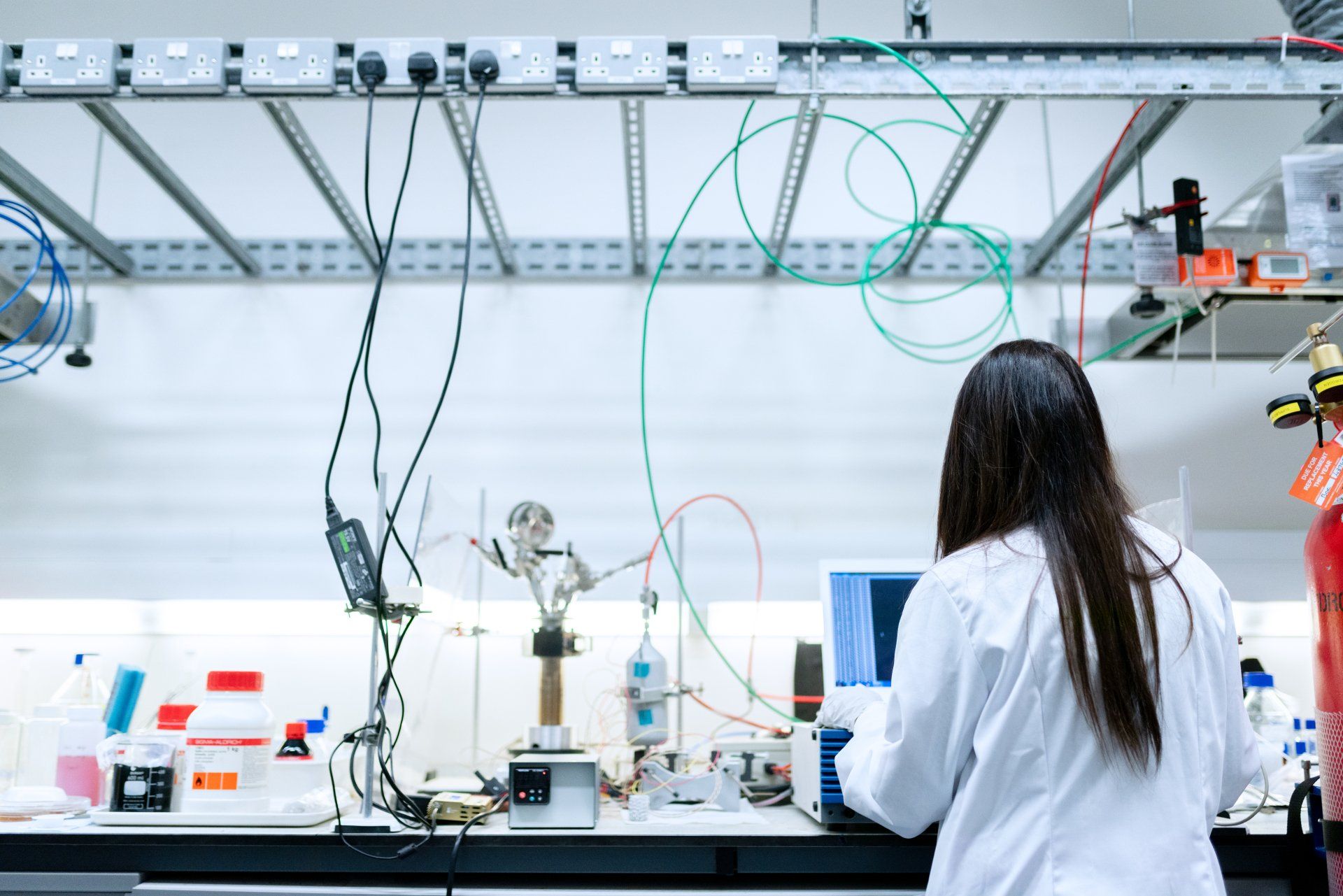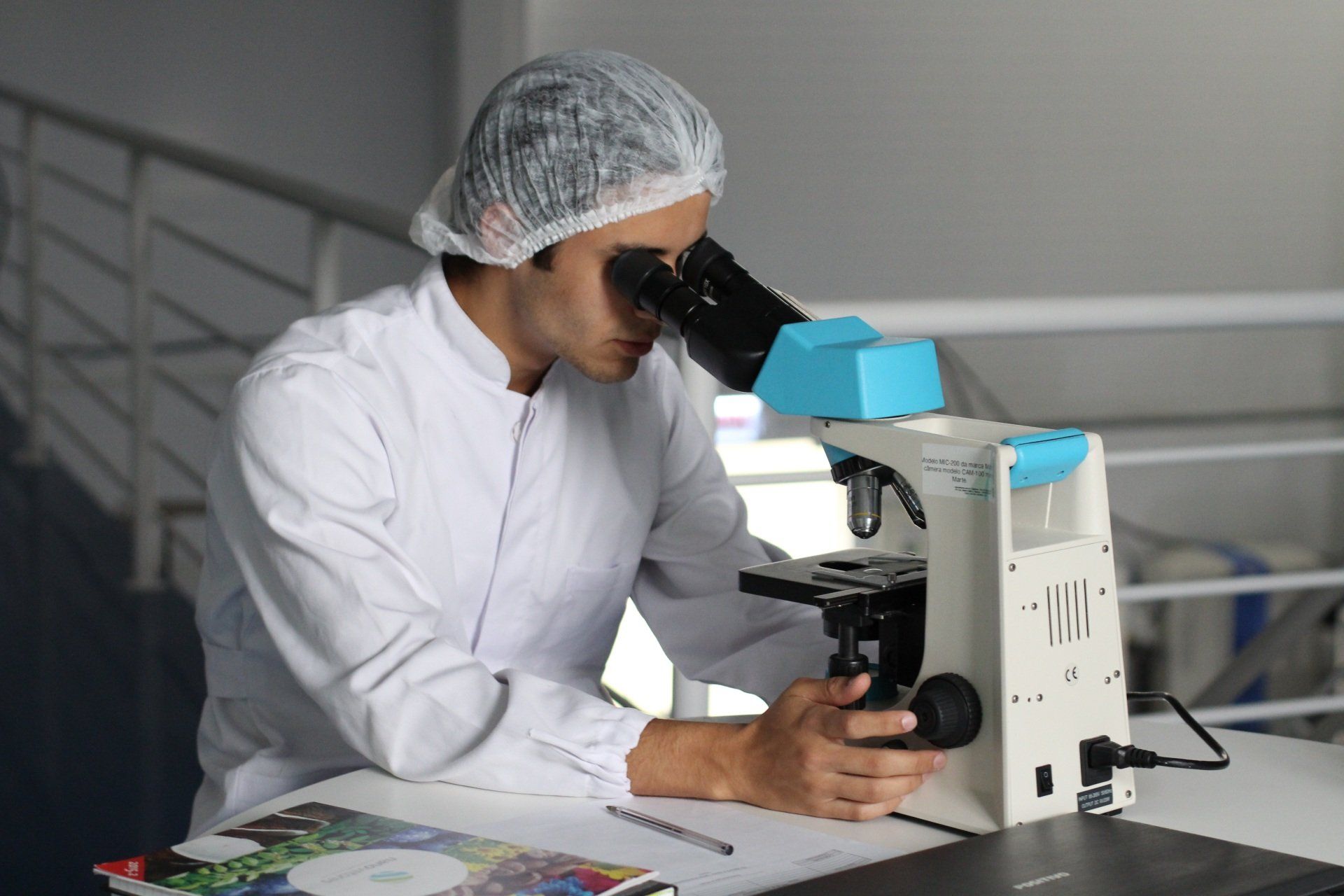What Are Regenerative Therapies?
Regenerative therapies support the body's ability to heal itself. Here are some of the most potent regenerative therapies...
Stem Cell Therapy
Leading the way in regenerative medicine, stem cells have been used for decades in many countries around the world with amazing success!
What Are Stem Cells And What Do They Actually Do?
The basic explanation for the seemingly mysterious concept of stem cell therapy, is as follows. First of all, a stem cell is simply a daughter cell (which is what all cells start out as before they become specific in their function). In other words, before a cell is assigned by the body to transform into a specialized type of cell such as a bone cell, muscle cell, or brain cell, it is a stem cell. A stem cell is like a "blank cell" that has not yet been defined by the body. Kind of like a hard drive that has not been imprinted with any information yet.
Our own body generates these stem cells from our bone marrow, but they are also found in the early developing fetus, in amniotic fluid, in placental blood and umbilical cord blood.
When stem cells are harvested and injected into someone's body, they have the capacity to go where they are needed to regenerate new healthy cells. In other words, they communicate with our immune system to heal unhealthy areas of our body and stimulate new healthy cell growth.
THE DATA BELOW IS FROM THE MAYO CLINIC WEBSITE...
You've heard about stem cells in the news, and perhaps you've wondered if they might help you or a loved one with a serious disease. You may wonder what stem cells are, how they're being used to treat disease and injury, and why they're the subject of such vigorous debate...Here are some answers to frequently asked questions about stem cells.
Stem cells: The body's master cells. Stem cells are the body's raw materials — cells from which all other cells with specialized functions are generated. Under the right conditions in the body or a laboratory, stem cells divide to form more cells called daughter cells.
These daughter cells become either new stem cells or specialized cells (differentiation) with a more specific function, such as blood cells, brain cells, heart muscle cells or bone cells. No other cell in the body has the natural ability to generate new cell types.
Why is there such an interest in stem cells?
Researchers hope that further stem cell studies can help to:
- Increase understanding of how diseases occur. By watching stem cells mature into cells in bones, heart muscle, nerves, and other organs and tissue, researchers may better understand how diseases and conditions develop.
- Generate healthy cells to replace cells affected by disease (regenerative medicine). Stem cells can be guided into becoming specific cells that can be used in people to regenerate and repair tissues that have been damaged or affected by disease.
- People who might benefit from stem cell therapies include those with spinal cord injuries, type 1 diabetes, Parkinson's disease, amyotrophic lateral sclerosis, Alzheimer's disease, heart disease, stroke, burns, cancer and osteoarthritis.
- Stem cells may have the potential to be grown to become new tissue for use in transplant and regenerative medicine. Researchers continue to advance the knowledge on stem cells and their applications in transplant and regenerative medicine.
- Test new drugs for safety and effectiveness. Before using investigational drugs in people, researchers can use some types of stem cells to test the drugs for safety and quality. This type of testing will most likely first have a direct impact on drug development for cardiac toxicity testing.
- New areas of study include the effectiveness of using human stem cells that have been programmed into tissue-specific cells to test new drugs. For the testing of new drugs to be accurate, the cells must be programmed to acquire properties of the type of cells targeted by the drug. Techniques to program cells into specific cells are under study.
- For instance, nerve cells could be generated to test a new drug for a nerve disease. Tests could show whether the new drug had any effect on the cells and whether the cells were harmed.
Where do stem cells come from?
There are several sources of stem cells:
- Embryonic stem cells. These stem cells come from embryos that are 3 to 5 days old. At this stage, an embryo is called a blastocyst and has about 150 cells.
- These are pluripotent (ploo-RIP-uh-tunt) stem cells, meaning they can divide into more stem cells or can become any type of cell in the body. This versatility allows embryonic stem cells to be used to regenerate or repair diseased tissue and organs.
- Adult stem cells. These stem cells are found in small numbers in most adult tissues, such as bone marrow or fat. Compared with embryonic stem cells, adult stem cells have a more limited ability to give rise to various cells of the body.
- Until recently, researchers thought adult stem cells could create only similar types of cells. For instance, researchers thought that stem cells residing in the bone marrow could give rise only to blood cells.
- However, emerging evidence suggests that adult stem cells may be able to create various types of cells. For instance, bone marrow stem cells may be able to create bone or heart muscle cells.
- This research has led to early-stage clinical trials to test usefulness and safety in people. For example, adult stem cells are currently being tested in people with neurological or heart disease.
- Adult cells altered to have properties of embryonic stem cells. Scientists have successfully transformed regular adult cells into stem cells using genetic reprogramming. By altering the genes in the adult cells, researchers can reprogram the cells to act similarly to embryonic stem cells.
- This new technique may allow use of reprogrammed cells instead of embryonic stem cells and prevent immune system rejection of the new stem cells. However, scientists don't yet know whether using altered adult cells will cause adverse effects in humans.
- Researchers have been able to take regular connective tissue cells and reprogram them to become functional heart cells. In studies, animals with heart failure injected with new heart cells experienced improved heart function and survival time.
- Perinatal stem cells. Researchers have discovered stem cells in amniotic fluid as well as umbilical cord blood. These stem cells have the ability to change into specialized cells.
- Amniotic fluid fills the sac that surrounds and protects a developing fetus in the uterus. Researchers have identified stem cells in samples of amniotic fluid drawn from pregnant women for testing or treatment — a procedure called amniocentesis.
Read more...
Nutritional Therapy
Therapeutic Nutritional Ketosis For Stopping Cancer Growth
Ozone Therapy
The Power Of Oxygen (Ozone Therapy) And Immune-Based Therapy In
The Destruction Of Unhealthy Cells
Having high levels of oxygen in your body triggers the release of naturally occurring substances (like stem cells) that stimulate the healing process. Oxygen also helps destroy bacteria, viruses and cancer cells because these things cannot survive in an oxygen rich environment.
German doctor, Otto Warburg was awarded the Nobel Prize in 1931 for his research proving that cancer cells use a form of non-oxygen metabolism to survive. Cancer cells are not like normal healthy cells. The way they metabolize and create energy is different from normal healthy cells and requires the fermentation of sugar and an environment that is low in oxygen.
Warburg emphasized that you can’t make a cell ferment unless a lack of oxygen is involved. In 1955, two American scientists, R.A. Malmgren and C.C. Flanigan, confirmed Warburg’s findings. They found that oxygen deficiency is ALWAYS present when cancer develops.
What Warburg found, however, is you can reverse fermentation simply by adding oxygen. When you flood the cancer cell with oxygen, you can regain apoptosis, their programmable cell death. If you put enough oxygen into a cancer cell it will turn on the Krebs Cycle (the mitochondria) and this reignites the process of programmed cell death know as apoptosis.
By hyper-oxygenating your body, it can help to make cancer cells easier to kill with treatments like chemotherapy and radiation. Ozone therapy decreases glucose in the blood, reduces inflammation and pain, improves the performance of white blood cells, and triggers the production of new healthy (stem) cells.
HOW DOES OZONE WORK?
Ozone therapy causes an increase in the red blood cell glycolysis rate. This leads to the stimulation of 2,3-diphosphoglycerate which leads to an increase in the amount of oxygen released to the tissues. Ozone activates the Krebs cycle by enhancing oxidative carboxylation of pyruvate, stimulating production of ATP. It also causes a significant reduction in NADH and helps to oxidize cytochrome C. There is a stimulation of production of enzymes which act as free radical scavengers and cell-wall protectors: glutathione peroxidase, catalase and superoxide dismutase. Production of prostacyline, a vasodilator, is also induced by O3.
Read more...
Immune Therapy For The Treatment Of Cancer
High Dose Vitamin C For The Treatment Of Cancer
“These findings showed, for the first time, a direct relationship between HIF-1 and vitamin C levels in tumours and suggested it would be beneficial for people with cancer cells to have more vitamin C. This could help limit the rate of tumour growth, increase the responsiveness to chemotherapy and may prevent the formation of solid tumours,’’ Vissers says.Our experience has shown that intravenous vitamin C therapy improves outcomes for cancer patients in a number of ways, including quality of life benefits, such as improved appetite, reduced pain, and overall well-being. We have also seen, on a case-by-case basis, increased longevity and improved prognosis,’’ Vissers worked with the Christchurch Cancer Society Tissue Bank to undertake the first-ever analysis of tumour ascorbate (vitamin C) levels and to relate these to tumour growth promoters. Her results were published in the Cancer Research journal. Read more...
RESOURCES ON VITAMIN C AND CANCER:
- Vitamin C physiology: the known and the unknown and Goldilocks Sebastian J Padayatty, Mark Levine Oral Dis. Author manuscript; available in PMC 2017 Sep 1. Published in final edited form as: Oral Dis. 2016 Sep; 22(6): 463–493. Published online 2016 Apr 14. doi: 10.1111/odi.12446 PMCID: PMC4959991
- ArticlePubReaderPDF–2.0MCite Select item 7918462
- Vitamin C—Sources, Physiological Role, Kinetics, Deficiency, Use, Toxicity, and Determination Martin Doseděl, Eduard Jirkovský, Kateřina Macáková, Lenka Kujovská Krčmová, Lenka Javorská, Jana Pourová, Laura Mercolini, Fernando Remião, Lucie Nováková, Přemysl Mladěnka, on behalf of The OEMONOM Nutrients. 2021 Feb; 13(2): 615. Published online 2021 Feb 13. doi: 10.3390/nu13020615 PMCID: PMC7918462
- ArticlePubReaderPDF–4.0MCite Select item 8392841
- Understanding the Therapeutic Potential of Ascorbic Acid in the Battle to Overcome Cancer Jurnal Reang, Prabodh Chander Sharma, Vijay Kumar Thakur, Jaseela Majee Biomolecules. 2021 Aug; 11(8): 1130. Published online 2021 Jul 31. doi: 10.3390/biom11081130 PMCID: PMC8392841
- ArticlePubReaderPDF–3.5MCite Select item 7503565
- Pathways of Gastric Carcinogenesis, Helicobacter pylori Virulence and Interactions with Antioxidant Systems, Vitamin C and Phytochemicals James W. T. Toh, Robert B. Wilson Int J Mol Sci. 2020 Sep; 21(17): 6451. Published online 2020 Sep 3. doi: 10.3390/ijms21176451 PMCID: PMC7503565
- ArticlePubReaderPDF–5.2MCite Select item 7765979
- Vitamin C Transporters and Their Implications in Carcinogenesis Kinga Linowiecka, Marek Foksinski, Anna A. Brożyna Nutrients. 2020 Dec; 12(12): 3869. Published online 2020 Dec 18. doi: 10.3390/nu12123869 PMCID: PMC7765979
- ArticlePubReaderPDF–819KCite Select item 6942884
- Pro- and Antioxidant Effects of Vitamin C in Cancer in correspondence to Its Dietary and Pharmacological Concentrations Elzbieta Pawlowska, Joanna Szczepanska, Janusz Blasiak Oxid Med Cell Longev. 2019; 2019: 7286737. Published online 2019 Dec 24. doi: 10.1155/2019/7286737. PMCID: PMC6942884
- ArticlePubReaderPDF–773KCite Select item 7996511
- High-Dose Vitamin C in Advanced-Stage Cancer Patients Anna Zasowska-Nowak, Piotr Jan Nowak, Aleksandr Ciałkowska-Rysz Nutrients. 2021 Mar; 13(3): 735. Published online 2021 Feb 26. doi: 10.3390/nu13030735 PMCID: PMC7996511
- ArticlePubReaderPDF–462KCite Select item 8773188
- Chemical Stability of Ascorbic Acid Integrated into Commercial Products: A Review on Bioactivity and Delivery Technology Xin Yin, Kaiwen Chen, Hao Cheng, Xing Chen, Shuai Feng, Yuanda Song, Li Liang Antioxidants (Basel) 2022 Jan; 11(1): 153. Published online 2022 Jan 13. doi: 10.3390/antiox1101015 PMCID: PMC8773188
- ArticlePubReaderPDF–932KCite Select item 9352950
- The Anti-Leukemia Effect of Ascorbic Acid: From the Pro-Oxidant Potential to the Epigenetic Role in Acute Myeloid Leukemia S. Travaglini, C. Gurnari, S. Antonelli, G. Silvestrini, N. I. Noguera, T. Ottone, M. T. Voso Front Cell Dev Biol. 2022; 10: 930205. Published online 2022 Jul 22. doi: 10.3389/fcell.2022.930205 PMCID: PMC9352950
- ArticlePubReaderPDF–1.8MCite Select item 8876016
- Role of Vitamin C in Selected Malignant Neoplasms in Women Anna Markowska, Michał Antoszczak, Janina Markowska, Adam Huczyński Nutrients. 2022 Feb; 14(4): 882. Published online 2022 Feb 19. doi: 10.3390/nu14040882 PMCID: PMC8876016
- ArticlePubReaderPDF–1.0MCite Select item 4691042
- Old Things New View: Ascorbic Acid Protects the Brain in Neurodegenerative Disorders Adriana Covarrubias-Pinto, Aníbal Ignacio Acuña, Felipe Andrés Beltrán, Leandro Torres-Díaz, Maite Aintzane Castro Int J Mol Sci. 2015 Dec; 16(12): 28194–28217. Published online 2015 Nov 27. doi: 10.3390/ijms161226095 PMCID: PMC4691042
- ArticlePubReaderPDF–1.0MCite Select item 6356429
- Ascorbic Acid Mitigates D-galactose-Induced Brain Aging by Increasing Hippocampal Neurogenesis and Improving Memory Function Sung Min Nam, Misun Seo, Jin-Seok Seo, Hyewhon Rhim, Sang-Soep Nahm, Ik-Hyun Cho, Byung-Joon Chang, Hyeon-Joong Kim, Sun-Hye Choi, Seung-Yeol Nah Nutrients. 2019 Jan; 11(1): 176. Published online 2019 Jan 15. doi: 10.3390/nu11010176 PMCID: PMC6356429
- ArticlePubReaderPDF–3.2MCite Select item 7460366
- Trying to Solve the Puzzle of the Interaction of Ascorbic Acid and Iron: Redox, Chelation and Therapeutic Implications George J. Kontoghiorghes, Annita Kolnagou, Christina N. Kontoghiorghe, Loukia Mourouzidis, Viktor A. Timoshnikov, Nikolay E. Polyakov Medicines (Basel) 2020 Aug; 7(8): 45. Published online 2020 Jul 30. doi: 10.3390/medicines7080045 PMCID: PMC746036 ArticlePubReaderPDF–1.6MCite Select item 5784034
- In vivo fluorescence bioimaging of ascorbic acid in mice: Development of an efficient probe consisting of phthalocyanine, TEMPO, and albumin Takanori Yokoi, Takayuki Otani, Kazuyuki Ishii Sci Rep. 2018; 8: 1560. Published online 2018 Jan 24. doi: 10.1038/s41598-018-19762-8 PMCID: PMC5784034 ArticlePubReaderPDF–2.8MCite Select item 8557029
- High-dose intravenous vitamin C, a promising multi-targeting agent in the treatment of cancer Franziska Böttger, Andrea Vallés-Martí, Loraine Cahn, Connie R. Jimenez J Exp Clin Cancer Res. 2021; 40: 343. Published online 2021 Oct 30. doi: 10.1186/s13046-021-02134-y PMCID: PMC8557029 ArticlePubReaderPDF–2.8MCite Select item 4684305
- Plasma Ascorbic Acid, A Priori Diet Quality Score, and Incident Hypertension: A Prospective Cohort Study Brian Buijsse, David R. Jacobs, Jr., Lyn M. Steffen, Daan Kromhout, Myron D. Gross PLoS One. 2015; 10(12): e0144920. Published online 2015 Dec 18. doi: 10.1371/journal.pone.0144920 PMCID: PMC4684305 ArticlePubReaderPDF–702KCite Select item 8156420
- Vitamin C Deficiency in the Young Brain—Findings from Experimental Animal Models Pernille Tveden-Nyborg Nutrients. 2021 May; 13(5): 1685. Published online 2021 May 15. doi: 10.3390/nu13051685 PMCID: PMC8156420 ArticlePubReaderPDF–2.2MCite Select item 7443979
- Therapeutic Targeting of SDHB-Mutated Pheochromocytoma/Paraganglioma with Pharmacologic Ascorbic Acid
- Yang Liu, Ying Pang, Boqun Zhu, Ondrej Uher, Veronika Caisova, Thanh-Truc Huynh, David Taieb, Katerina Hadrava Vanova, Hans Kumar Ghayee, Jiri Neuzil, Mark Levine, Chunzhang Yang, Karel Pacak
- Clin Cancer Res. Author manuscript; available in PMC 2020 Aug 24.
- Published in final edited form as: Clin Cancer Res. 2020 Jul 15; 26(14): 3868–3880. Published online 2020 Mar 9. doi: 10.1158/1078-0432.CCR-19-2335
- PMCID: PMC7443979 ArticlePubReaderPDF–2.1MCite Select item 5442716
- Ascorbic Acid Promotes the Stemness of Corneal Epithelial Stem/Progenitor Cells and Accelerates Epithelial Wound Healing in the Cornea Jialin Chen, Jie Lan, Dongle Liu, Ludvig J. Backman, Wei Zhang, Qingjun Zhou, Patrik Danielson Stem Cells Transl Med. 2017 May; 6(5): 1356–1365. Published online 2017 Mar 9. doi: 10.1002/sctm.16-0441PMCID: PMC5442716 ArticlePubReaderPDF–761KCite Select item 7312906
- Redox Interactions of Vitamin C and Iron: Inhibition of the Pro-Oxidant Activity by Deferiprone Viktor A. Timoshnikov, Tatyana V. Kobzeva, Nikolay E. Polyakov, George J. Kontoghiorghes Int J Mol Sci. 2020 Jun; 21(11): 3967. Published online 2020 May 31. doi: 10.3390/ijms21113967 PMCID: PMC7312906
RESOURCES ON OZONE/OXYGEN THERAPY AND CANCER:
- MERS, SARS, and emerging Coronaviruses: theoretical considerations and a proposal for critical care parenteral oxygen/ozone therapy: http://www.triroc.com/sunnen/topics/sars.html
- Hyperbaric oxygen inhibits benign and malignant human mammary epithelial cell proliferation.
- Granowitz EV, Tonomura N, Benson RM, Katz DM, Band V, Makari-Judson GP, Osborne BA
- Anticancer Res. 2005 Nov-Dec; 25(6B):3833-42.
- Apoptosis of T-leukemia and B-myeloma cancer cells induced by hyperbaric oxygen increased phosphorylation of p38 MAPK.
- Chen YC, Chen SY, Ho PS, Lin CH, Cheng YY, Wang JK, Sytwu HK
- Leuk Res. 2007 Jun; 31(6):805-15.
- Effect of hyperbaric oxygen on the anticancer effect of artemisinin on molt-4 human leukemia cells.
- Ohgami Y, Elstad CA, Chung E, Shirachi DY, Quock RM, Lai HC
- Anticancer Res. 2010 Nov; 30(11):4467-70.
- Daruwalla J, Christophi C. The effect of hyperbaric oxygen therapy on tumour growth in a mouse model of colorectal cancer liver metastases. Eur J Cancer. 2006;42:3304–3311. doi: 10.1016/j.ejca.2006.08.004.
- Evaluation of the effect of SMA-pirarubicin micelles on colorectal cancer liver metastases and of hyperbaric oxygen in CBA mice.
- Daruwalla J, Greish K, Nikfarjam M, Millar I, Malcontenti-Wilson C, Iyer AK, Christophi C
- J Drug Target. 2007 Aug-Sep; 15(7-8):487-95.
- Emerging roles of ozone in skin diseases Zhong Nan Da Xue Xue Bao Yi Xue Ban 2018
- Inactivation of fungi associated with barley grain by gaseous ozone J Environ Sci Health B 2003
- Validity of Oxygen-Ozone Therapy as Integrated Medication Form in Chronic Inflammatory Diseases
- Cardiovasc Hematol Disord Drug Targets 2015 Anton syndrome during oxygen-ozone therapy
- Am J Emerg Med 2015 Precise application of Traditional Chinese Medicine in minimally-invasive techniques
- Zhongguo Gu Shang 2018
Start Producing Ketones In 5 Days

Contact Us
Connect with me on social media...
Linkedin: www.linkedin.com/in/mary-beauchamp-rn
FB Page: https://www.facebook.com/ketogenicdietcoach
YouTube Channel: http://www.youtube.com/c/MaryBeauchampRN
Instagram: https://www.instagram.com/ketogenicdietcoach/
Twitter:
https://twitter.com/ketodietcoach
Mary Beauchamp
Best Selling Author
Registered Nurse
Ketogenic Diet Specialist
GAPS™Certified Practitioner
(Gut and Psychology Syndrome)
Mary Beauchamp’s deepest intention is to set people free. Her mission is to make people aware and conscious so that with that awareness, they can begin to heal and live deeply meaningful, integrated and empowered lives.
Drawing from her experiences growing up on a farm, raising her four children and traveling the world, her work provides a road map for health transformation through unlocking the body’s innate intelligence to heal and thrive.
Mary works with a team of Naturopathic doctors. She offers coaching programs, and retreats. You can learn more about her work by visiting her website, www.ketogenicdietcoach.com. Mary is passionate about re-educating people about nutrition. She invites you to experience your body as a master communication system and facilitates this sacred encounter within.













